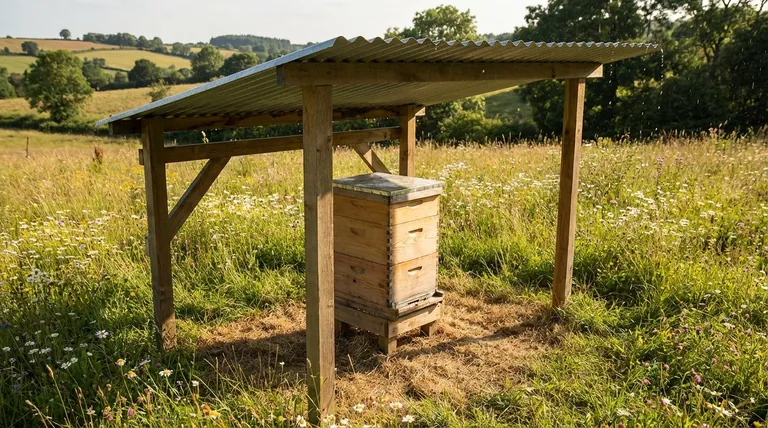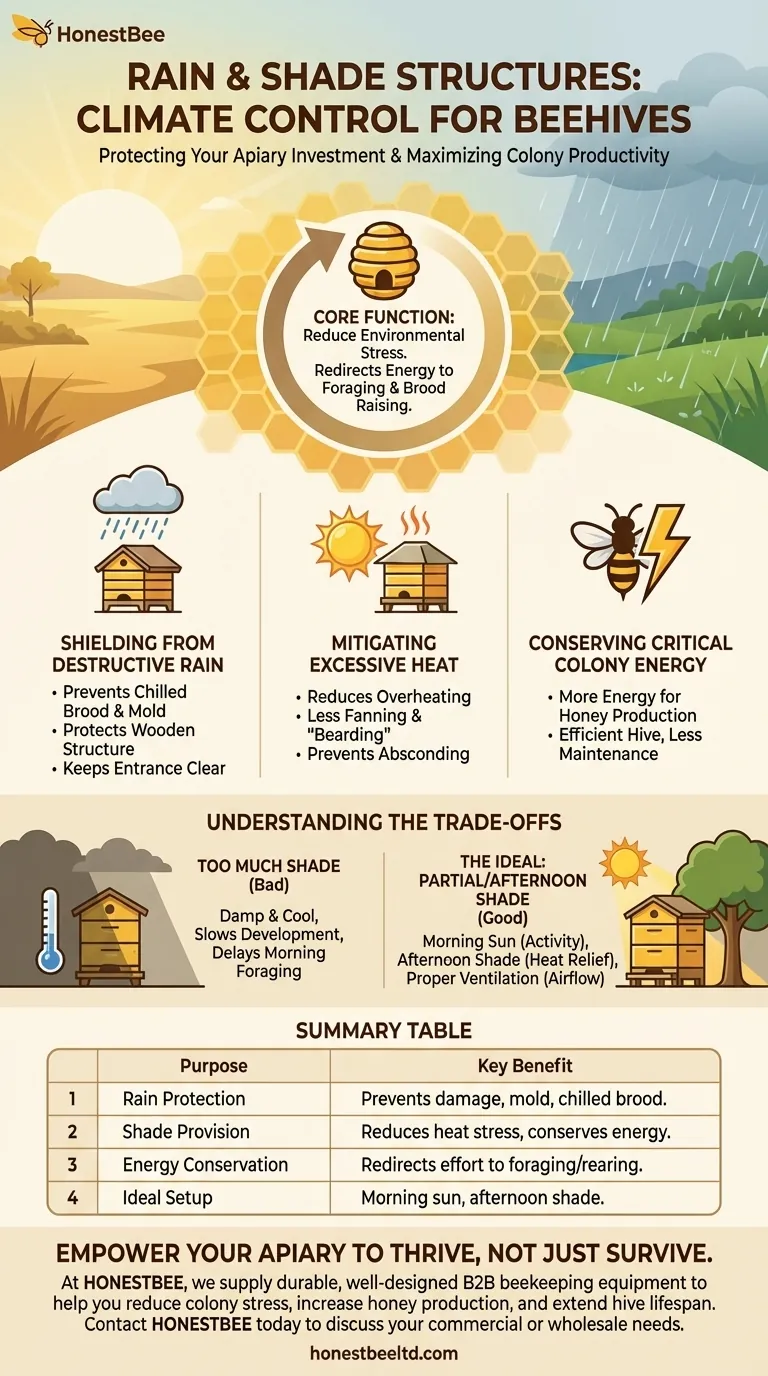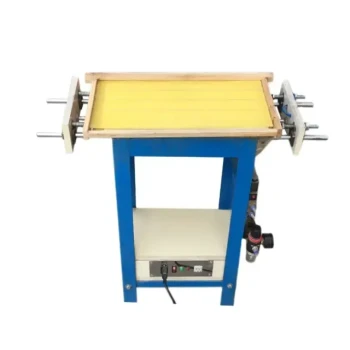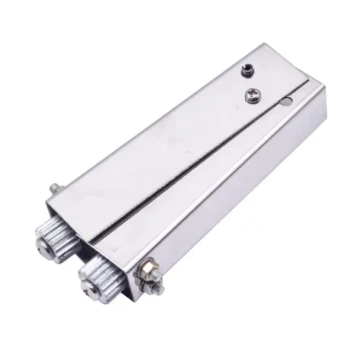In essence, rain and shade structures are a form of climate control for your beehive. They serve the critical purpose of protecting the colony from the destructive elements of direct rainfall and excessive solar heat. This protection is not just for comfort; it is essential for the colony's survival, energy conservation, and overall productivity.
The core function of these structures is to reduce environmental stress on the colony. By managing extreme temperatures and moisture, you allow the bees to redirect their energy from constant hive maintenance and climate control toward more productive tasks like foraging and raising brood.

The Critical Role of Environmental Stability
A beehive is a finely tuned superorganism that works constantly to maintain a stable internal environment. External weather extremes directly threaten this delicate balance, forcing the colony to expend precious resources in response.
Shielding from Destructive Rain
Rain poses a direct physical threat to bees and their home. A solid cover prevents water from seeping into the hive, which can chill the brood, promote mold, and damage the wooden structure over time.
It also keeps the entrance clear, preventing foraging bees from being beaten down by heavy rain as they attempt to enter or exit the hive.
Mitigating Excessive Heat
A hive sitting in direct, intense sun can quickly overheat. Bees must work tirelessly to regulate the internal temperature, primarily through fanning their wings and evaporative cooling (a behavior known as "bearding").
This constant effort diverts a significant portion of the workforce away from foraging for nectar and pollen. In extreme cases, severe overheating can even cause a colony to abscond, abandoning the hive entirely.
Conserving Critical Colony Energy
The most significant benefit of providing shade and rain protection is the conservation of the colony's energy.
Every bit of energy spent on fanning to cool the hive or on repairing water damage is energy that cannot be used for raising young bees, defending the hive, or producing honey. A sheltered hive is an efficient hive.
Understanding the Trade-offs
While protection is vital, the implementation requires a balanced approach. Simply placing a hive in deep, permanent shade is not the ideal solution and can create new problems.
The Problem with Too Much Shade
Hives located in constant, dense shade can become damp and cool. This can slow the colony's development, especially in the spring.
Bees are also less active on cool mornings. A lack of morning sun can delay the start of their daily foraging, reducing overall productivity.
The Ideal: Partial or Afternoon Shade
The most beneficial arrangement provides sun in the morning and shade during the hottest part of the afternoon.
Morning sun warms the hive and encourages the bees to begin foraging early. Shade from the intense midday and afternoon sun prevents overheating and reduces the cooling burden on the colony.
Ensuring Proper Ventilation
Any structure built over a hive must not impede airflow. A cover that traps heat and moisture can be more harmful than no cover at all.
Proper ventilation is key to allowing the bees' own cooling mechanisms to work efficiently and prevents the buildup of excess humidity within the hive.
Making the Right Choice for Your Apiary
Your approach to providing shelter should be guided by your specific climate and goals.
- If your primary focus is colony health in a hot climate: Prioritize providing reliable afternoon shade to minimize heat stress and conserve the bees' energy.
- If your primary focus is hive longevity in a wet climate: Ensure a durable, waterproof cover is in place to protect the wooden components from rot and keep the interior dry.
- If your primary focus is maximizing honey production: Use strategic shade to reduce the energy your bees spend on thermoregulation, allowing them to redirect that effort toward collecting nectar.
By actively managing the microclimate around your hive, you empower your colony to thrive rather than just survive.
Summary Table:
| Purpose | Key Benefit |
|---|---|
| Rain Protection | Prevents water damage, mold, and brood chilling. |
| Shade Provision | Reduces heat stress, conserves bee energy, and prevents absconding. |
| Energy Conservation | Redirects bee effort from cooling/repairs to foraging and brood rearing. |
| Ideal Setup | Morning sun for activity, afternoon shade for heat relief. |
Empower your apiary to thrive, not just survive.
As a commercial beekeeper or distributor, every decision impacts your bottom line. At HONESTBEE, we understand that protecting your investment in bee colonies is paramount. Our wholesale-focused operations supply durable, well-designed beekeeping supplies and equipment—including materials for effective rain and shade structures—that help you:
- Reduce colony stress and minimize losses.
- Increase honey production by allowing bees to focus on foraging.
- Extend the lifespan of your hive equipment by protecting it from the elements.
Let us help you build a more resilient and productive operation. Contact HONESTBEE today to discuss your commercial or wholesale equipment needs.
Visual Guide

Related Products
- Professional Galvanized Hive Strap with Secure Locking Buckle for Beekeeping
- Professional Drop-Style Hive Handles for Beekeeping
- Versatile Ratchet Hive Strap with S-Hooks for Secure Fastening
- Professional Grade Foldable Beehive Handles
- Professional Engraved Round Hive Number Tags for Beekeeping
People Also Ask
- How should a cam buckle strap be installed for optimal performance? Master the Leverage for Maximum Tension
- What is the advantage of using cam buckle straps? Secure Your Load Fast with Simple, Safe Tensioning
- Why are hive straps important for beekeepers? Secure Your Hives Against Wind, Predators & Transport
- What is the best length for straps used around beehives? Why 12 Feet is the Industry Standard
- What are the types of Emlocks available? Choose the Right Strap for Hive Security



















